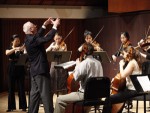Title
A year ago, harpsichordist William Christie and members of his period ensemble Les Arts Florissants first came to Juilliard for a week to work with students on Baroque instruments. The residency culminated in an interactive public “works in progress” program in which Christie and the students addressed many of the issues of Baroque performance practice. It was the first time many Baroque instruments were featured on a large scale at Juilliard. This year, Christie and members of his ensemble returned and worked with the students—many of whom were themselves returning, now more experienced. There were also new participants, hand-picked from auditions held last fall. The participants were Juilliard alums and current students, as well as students in the Academy program (in partnership with Carnegie Hall).
Body
This year’s theme was the music of Handel and his contemporaries. The weeklong event was vastly different from last year’s, as the culmination was not an interactive master class but a true concert (which served as this season’s annual Jerome L. Greene concert of Baroque music) given by the students. And, because many of them had spent a year or more with the instruments, the level of performance had greatly increased. This year also included Baroque bassoons and oboes. These improvements and additions made it possible to have a complete Baroque orchestra—a performance of which, as far as anyone knows, had never taken place in the history of Juilliard.
The feeling I had after participating in the weeklong residency was similar to summer-camp nostalgia. Although I knew most of the people I played with, I felt I got to know them in a new light. The individual chamber groups I played with were like different families and we had our own unique issues. I will not soon forget one particularly humbling issue I had with one group; Florence Malgoire, a violinist in Les Arts Florissants, was the coach for this ensemble. She asked us numerous times to play the opening bars of the Allegro from Handel’s Sonata a Cinque in B Flat. The bars consist simply of unison eighth notes and 16th notes, but we couldn’t seem to get the feeling just right. It reminded me of what Christie mentioned in one of the orchestra rehearsals: It is the habit of modern players to “play what they see.” In most modern scores, the pages are packed full of many performance indications; in Baroque music, this is not the case. Many of the missing items include dynamics, articulations, rhythmic alterations (such as double dotting, notes inégales, and under-dotting), and others. Florence told us to “swing” the notes, but to maintain the nonchalant quality. We couldn’t seem to maintain the balance of feeling the 4/4 while lightening the unimportant beats. By the time of the concert, however, it seemed as if we had “grown into” the music, and it had become a part of our familial unit.
This reminds me of another thing Christie said in one of the orchestra rehearsals. Because there is so much to be interpreted or realized in the music, the result becomes something of a synthesis of composer and performer. He used the example of pianist Alfred Brendel and Schubert. The performance becomes something other than the actual music of Schubert; instead, it becomes Brendel-Schubert. When Glenn Gould played Bach, it was unlike any other performance and therefore became Gould-Bach. Therefore, as Christie was in front of us, conducting this unique group of individuals, he made us all realize just how special this opportunity was: When we, as a Baroque orchestra at Juilliard, perform the Handel Concerto Grosso, Op. 3, it becomes Juilliard-Handel! Having many elements missing from a score actually becomes a gift to the performer, providing the opportunity to fill in the blanks. Artistic interpretation is invited—in fact, it is necessary in Baroque music.
One of my friends, cellist Christine Lamprea, a participant in the workshop, commented to me about her experience. An undergraduate, Christine had never played a cello in the Baroque setup and pitch. She had to support the cello between her knees without an endpin, use an arched Baroque bow, and play on gut strings. I found her performance to be as convincing as that of a seasoned Baroque performer. She said, “For me, a first-time Baroque player, William Christie unveiled a new beauty and excitement in Baroque music that I had not experienced before. It opened a door to another venue of performance I might consider.”
It is exciting to see so much life being infused into an era of music that has been long misunderstood. Baroque music is being given a new life in the halls and performance spaces of Juilliard.





